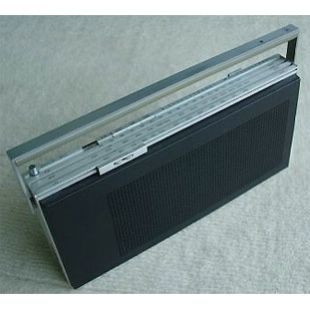
BeoLit 600 (1970)
“Bang & Olufsen (the Volvo of electronics) have [one transistor] radio so elegant you can’t tell what it is, a completely anonymous plastic box that might well contain paper tissues, did it not appear to have a slide rule glued to one edge. That’s not the real trannie market, of course,; that’s just an executive […]
Overview
“Bang & Olufsen (the Volvo of electronics) have [one transistor] radio so elegant you can’t tell what it is, a completely anonymous plastic box that might well contain paper tissues, did it not appear to have a slide rule glued to one edge. That’s not the real trannie market, of course,; that’s just an executive toy for the man who already has hi-fi” – The art historian Rayner Banham in New Society 1974
Rayner Banham was one of the first to acknowledge that the youth and pop culture had the same artistic value as that all too objective modernistic demonstrating an anonymous anti-design. The first portable transistor radios appeared at the end of the 1950s, and during the 1960s they became part of youth culture. The early portable radios, including those from B&O, looked like ladies’ handbags and were anything but exclusive.
The Beolit 600 is an example of how Jensen goes in exactly the opposite direction from his competitors. Now the radio has become a design icon, a cult object, but in reality is something as banal as a redesign of B&O’s earlier, somewhat uninteresting, wood-clad transistor model – the Beolit 1000. Jensen compressed the cabinet until it was completely flat, very long and not very deep – an exciting and very architectonic shape. The openings for the loudspeakers were square and together constituted an asymmetrically placed rectangle.
People would take the transistor radio to the beach, so Jensen did what he could to make is sand proof and robust. A Plexiglas plate would not be appropriate, as it would be scratched if sand got underneath it. Jensen had the idea of taking the indicator down into the actual aluminium profile. It became a metal ball down in a groove. Jensen’s friend, the brilliant engineer Karl Gustav Zeuthen (the creator of Danish KZ aeroplanes), developed the system so that a magnet dragged the ball along down in the aluminium profile – flush again.
The sandwich construction consists of two plastic trays that can be removed in order to change batteries. They click into place on the aluminium frame. The plastic had a special velvety texture, a rough effect exuding quality. The model in black resembles charcoal. A smart detail is in the handle which can be tipped to one side as a support so that the radio can conveniently lie obliquely with the controls in front of you or on your work desk. After one of B&O’s factory buildings burned down, one of the employees happened to switch on a Beolit that had completely melted down and it played quite happily in spite of it all! ” taken from ‘Jacob Jensen’ by Christain Holmsted Olesen.
Beolit 400 – 600 range
A new range of transportable radios – the Beolit – was launched in 1970. The sound reproduction was unusually good – so good that many of the Beolits are still in use. In principle, the units were battery-powered, but the 600 version could also be connected to the mains. An amusing detail was the indication, of the selected station. This was shown by a small metal ball which moved behind a glass cover in parallel with a magnet on the exterior control slide and was thus encased and protected. Despite its sophisticated exterior, the Beolit was extremely robust.
With Beolit 600 the designer Jacob Jensen set a new standard for the manufacture and design of transistor radios. In its construction, details and finish the radio pursued the same straight lines which have always characterised B&O’s products. The radio was very functional and easy to operate.
Beolit 600: The transistor radio was one of Bang & Olufsen’s greatest sales success stories. At one time the B&O factory in Struer manufactured 600 units a day!
Even though it was light and compact it had surprisingly good sound. The solution of the scale by means of magnetic balls was both elegant and functional even though it was later overhauled by digital methods. An example of good-quality design work is the technique that can be developed and refined through time; another is the longevity of quality design. Jensen’s Beolit 600 was special because it took design seriously. Jacob Jensen was awarded the Danish Design Centre’s ID Prize in 1970 for his work with this product range.
Beolit 600 was a more comprehensive version of Beolit 400; the main difference being that AM was also included. Those radios sold in the UK offered MW and LW; in other markets the radio was fitted with two SW bands in their place. These sets also included fine-tuning controls for these bands. Another addition was that by pressing two of the band switches at the same time, the set became an amplifier and loudspeaker for use with a record player or tape recorder. An external loudspeaker or a pair of headphones could also be connected, either muting the internal loudspeaker or not, depending on how the plug was inserted.
The tuning pointer was also slightly different to that fitted to the Beolit 400. Instead of the plastic pointer, a magnet was fitted to the tuning slider inside the set, and this moved two steel balls in the grooves in the dial. Transparent plastic strips stopped them falling out should a jolt make them become detached from the magnet. This system would not work with the station markers, so these were not fitted.
In 1970, three Bang & Olufsen products designed by Jacob Jensen received the IF award. The winning products were: Beomic 2000 microphone, Beomaster 1200 tuner/amplifier and the Beolit 600 transistor radio.
“Congratulations! Well, we have done this before”, said Prince Henrik – The Queen of Denmark’s husband – when he presented the Danish ID award of the Society of Industrial Design to Bang & Olufsen, represented by Jacob Jensen, the designer. The remark made reference to the fact that B&O had also received the award the year before. The 1970 ID award was given to the Beolit 600 transistor radio, creating new norms for construction and design. That same year Beolit 600 also received the IF award.
Product Details
Software
No software information available.
Product Specification
Tuning:
FM 87.5 – 104 MHz
MW 520 – 1610 kHz, 578 – 186 m
LW 147 – 350 kHz, 2040 – 857 m
Amplifier:
Power output >1.2 watts (distortion : 10%
Frequency Response 50 – 20,000 Hz (- 3 dB)
Distortion < 1% at 50 mW/1000 Hz
Speaker:
Impedance 4 ohms
Continuous Load 3 W
Frequency Response 60 – 15,000 Hz
Specifications: Dimensions W x H x D: 22 x 6 x 36cm
Weight 2.55 kg
Voltage: 7.5 volts (five 1.5 volt dry cells (33 x 60.5mm)
Connections: Inputs Gramophone
160 mV – 1000 Hz / 200 k ohms
Tape recorder: Sensitivity: 160 mV – 1000 Hz / 200 k ohms
External power supply: 7.5 V
Outputs Extension speaker – 4 ohms
Tape recorder: Output signal: max. 100 mV / 1000 Hz for 100 % modulation
Output impedance: 39 k ohms
Downloads
Type | Language | Type | |
User Guide | EN | BeoLit 600 User Guide | |
Service Manual | EN | BeoLit 600 Service Manual | |
Service Manual | EN | BeoLit 600 Service Manual | |
Service Manual | EN | BeoLit 600 Service Manual |
Photo Gallery
No gallery images.
Frequently Asked Questions
No FAQs available.






